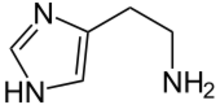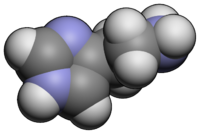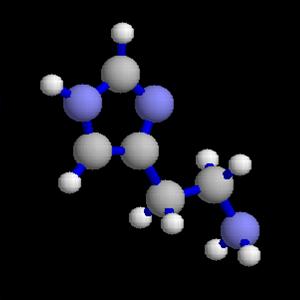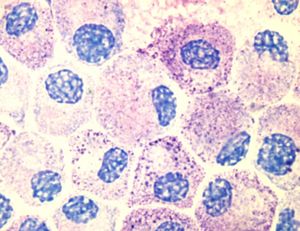هيستامين
ساهم بشكل رئيسي في تحرير هذا المقال
|

| |

| |
| الأسماء | |
|---|---|
| اسم أيوپاك
2-(1H-imidazol-4-yl)ethanamine
| |
| Identifiers | |
| رقم CAS | |
3D model (JSmol)
|
|
| ChemSpider | |
| ECHA InfoCard | 100.000.092 |
| عناوين مواضيع طبية MeSH | |
PubChem CID
|
|
CompTox Dashboard (EPA)
|
|
| SMILES | |
| الخصائص | |
| الصيغة الجزيئية | C5H9N3 |
| كتلة مولية | 111.15 g mol-1 |
| نقطة الانصهار | |
| نقطة الغليان | |
ما لم يُذكر غير ذلك، البيانات المعطاة للمواد في حالاتهم العيارية (عند 25 °س [77 °ف]، 100 kPa). | |
| مراجع الجدول | |
هستامين Histamine عبارة عن مركب أميني أحادي حيوي فعال Biogenic monoamine ينتج من فعل إنزيمات بكتيريا روث الإنسان والحيوان Fecal bacteria على المواد البروتينية وأخص الحمض الأميني الأساسي المسمى الهستيدين Histidine. والهستيدين هو حمض أميني أساسي أو شبه أساسي Essential amino acid وهو أحد مكونات المواد البروتينية والتي تتغذي عليها يوميا ولا تصاب بأي أذى منه وذلك لوجوده في جسم الجزئ البروتيني وليس حراً طليقاً ومشوهاً كما هو الحال في الأسماك والبروتينات التي بدأت في التحلل والتعطن والتعفن. ويفرز هذا النوع من السم أيضاً بكثرة في الجسم من قبل الخلايا المعروفة ب:Mast cell والمنتشرة في الأنسجة
الضامة Connective tissues، وأيضا من قبل خلايا الدم البيضاء المعروفة بالخلايا القاعديةBasophils وذلك أثناء تفاعلات الحساسية وصدمة الحساسية الخطيرة والمهددة للحياةAnaphylactic shock (وأثناء أمراض الحساسية المختلفة).
تتواجد خلايا الماست Mast cells بكثرة في كل من أنسجة الرئة وأغشية الأنف المخاطية وأنسجة العين المخاطية وتحت الجلد وبين الأنسجة المخاطية المختلفة. يستخدم الهستامين علاجيا كمادة تشخيصية لفحص كفاءة إفرازات الجهاز الهضمي وكعلاج لقاحي تدريجي لإزالة أو تخفيف استجابة الجسم للمستويات اDesensitizing agent، ولحالات بعض أنواع السرطانات المتقدمة، لفقدان السمع، مرض منيرMeniere’s disease، الآلام العصبية بالوجه Neuralgia of face، ولتشخيص حالات فصام العقل Schizophrenia وذلك لما له من خاصية فارماكولوجية عالية في توسيعه للأوعية الدموية وتحريضه على إنتاج وإفراز الحمض المعدي والعصارات المعوية وخاصة الإنزيم ببسين. يدخل في استجابة جهاز المناعة الموضعي وتنظيم إفراز وإنتاج حمض المعدة، وأثناء التفاعلات التحسسية (فرط الحساسية) حيث بعمل كوسيط مباشرة للتفاعلات التحسسية السريعة a mediator of immediate hypersensitivity، عندما يفرز ويحرر من قبل mast cells يؤدي إلى توسيع الأوعية الدموية ولزيادة نفاذية جدار الأوعية الدموية وهذا يؤدي إلى ظهور أعراض الحساسية مثل سيلان الأنف، تدميع العينينWatery eyes، وفي الرئة يؤدي تورم وضيق الممرات الهوائية لمنع الغبار ومسببات الحساسية allergens من الولوج إلى داخل الجسم والمحصلة لسوء الحظ هو صعوبة في التنفس (أزمة صدرية)، صدمة تحسسيه قاتلة أو فرط الحساسية. من هذا يتضح أن الهستامين ليس في حقيقته سماً، فهو هرمون حيوي داخلي مهم له وظائف مهمة يؤديها لحماية الكائن الحي مثله مثل باقي الهرمونات الأخرى المشابهة في التركيب الكيماوي والوظائف الفسيولوجية (السيروتينين والأدرينالين والنور أدرينالين وغيرها)، فكمياتهالدم عند الحاجة له تكون مقننة كما أنه يتأيض (تزال سميته) بسرعة في الدم بواسطة الإنزيمات التي تفرز إلى مجري لعالية من الهستامين.[1]
والهيستامين واسع الانتشار في المملكة الحيوانية والنباتية فهو يوجد في الدم والبول والعصارة المعدية،كذلك يوجد في الخلايا العصبية ويتكون في الجسم من الهيستددين بإزالة مجموعة الكاربوكسيل بالأنزيمHistidine decarboxylae
. . . . . . . . . . . . . . . . . . . . . . . . . . . . . . . . . . . . . . . . . . . . . . . . . . . . . . . . . . . . . . . . . . . . . . . . . . . . . . . . . . . . . . . . . . . . . . . . . . . . . . . . . . . . . . . . . . . . . . . . . . . . . . . . . . . . . . . . . . . . . . . . . . . . . . . . . . . . . . . . . . . . . . . .
التأثير الدوائي للهيستامين
1.الدورة الدموية:
يوسع الهيستامين الأوعية الدموية وخاصة الشعيرات الدموية ويسبب انخفاضا في ضغط الدم.وإذا كانت الجرعة كبيرة فانه يسبب صدمة تسمى صدمة الهيستامين ويصاحب توسع الشعيرات الدموية زيادة في النفاذ حيث تتسرب السوائل والبروتينات الموجودة في البلاسما مكونة الوذمة
2.العضلات الملساء:
ينبه الهيستامين العضلات الملساء الموجودة في الجسم وبخاصة عضلات القصبة الهوائية كما ينبه القناة الهضمية
3.التاثير على الغدد المفرزة:
يزيد الهيستامين من إفراز الغدد الموجودة في المعدة فيزيد من حموضة المعدة كذلك يزيد من إفراز اللعاب والبنكرياس
4.الاستجابة الثلاثية للهيستامين:
اذا حقن الهيستامين بجرعات صغيرة تحت الجلد فإنه يكون نقطة حمراء لا تلبث أن تأخذ مسحة زرقاء ثم يحدث تورم في منطقة قطرها حوالي 1سم حول النقطة السابقة وتكون أكثر احمرار ثم تتسرب السوائل الموجودة في الدم وبروتينات البلاسما وتتجمع مكونة وذمة في منطقة الحقن
مصيره
عندما يؤخذ الهيستامين عن طريق الفم فإنه يتحول _بتأثير جراثيم الأمعاء_إلى استيل هيستامين عديم التاثير .ولذلك إذا رغبنا في إبراز تأثير الهيستامين فعلينا أن نعطيعه حقنا .وعندما يصل الهيستامين إلى الدم فإنه لا يبقى في الدورة الدموية طويلا اذ يلتصق بكريات الدم الحمراء والأنسجة كما أنه يتحطم بخميرة الهيستاميناز...وتطرح مقادير ضئيلة من الهيستامين في البول عن طريق الكلى
الفوائد العلاجية
1.فحص وظيفة المعدة:
ويحقن لهذا الغرض 0.2-0.5ملغ تحت الجلد مع تتبع إفراز المعدة فإذا لم يحدث إفراز مطلقا استجابة للهيستامين فهذا معناه اضمحلال الغشاء المخاطي المبطن للمعدة بما يحتوي من خلايا مختصة بإفراز الحمض
2.يقي من الاستجابة العنيفة له:
عندما يعطى الهيستامين بجرعات ضئيلة جدا(1مل من محلول:10000000:1) لفترة من الوقت فإنه يقي من الاستجابة العنيفة له بعدئذ
البيتازول Betazole
وهو مماكب للهيستامين وينبه إفراز المعدة ولكنه لايحدث تأثيرات الهيستامين الأخرى ويستعمل كاختبار لوظيفة المعدة ويفضل على الهيستامين ويستخدم بشكل حقن تحتوي 50ملغ/مل
الخصائص
Histamine forms colorless hygroscopic crystals that melt at 84°C, and are easily dissolved in water or ethanol, but not in ether. In aqueous solution histamine exists in two tautomeric forms, Nπ-H-histamine and Nτ-H-histamine.
Histamine has two basic centres, namely the aliphatic amino group and whichever nitrogen atom of the imidazole ring does not already have a proton. Under physiological conditions, the aliphatic amino group (having a pKa around 9.4) will be protonated, whereas the second nitrogen of the imidazole ring (pKa ≈ 5.8) will not be protonated.[2] Thus, histamine is normally protonated to a singly-charged cation.
التركيب والأيض
Histamine is derived from the decarboxylation of the amino acid histidine, a reaction catalyzed by the enzyme L-histidine decarboxylase. It is a hydrophilic vasoactive amine.
Once formed, histamine is either stored or rapidly inactivated. Histamine released into the synapses is broken down by acetaldehyde dehydrogenase. It is the deficiency of this enzyme that triggers an allergic reaction as histamines pool in the synapses. Histamine is broken down by histamine-N-methyltransferase and diamine oxidase. Some forms of foodborne disease, so-called "food poisonings," are due to conversion of histidine into histamine in spoiled food, such as fish. Fermented foods and beverages naturally contain histamine due to this same conversion. Sake contains histamine in the 20-40 mg/L range; wines contain it in the 2-10 mg/L range. [3]
التخزين والاطلاق
Most histamine in the body is generated in granules in mast cells or in white blood cells called basophils. Mast cells are especially numerous at sites of potential injury - the nose, mouth, and feet, internal body surfaces, and blood vessels. Non-mast cell histamine is found in several tissues, including the brain, where it functions as a neurotransmitter. Another important site of histamine storage and release is the enterochromaffin-like (ECL) cell of the stomach.
The most important pathophysiologic mechanism of mast cell and basophil histamine release is immunologic. These cells, if sensitized by IgE antibodies attached to their membranes, degranulate when exposed to the appropriate antigen. Certain amines and alkaloids, including such drugs as morphine, and curare alkaloids, can displace histamine in granules and cause its release. Antibiotics like polymyxin are also found to stimulate histamine release.
آلية العمل
Histamine exerts its actions by combining with specific cellular histamine receptors. The four histamine receptors that have been discovered are designated H1 through H4, and are all G protein-coupled receptors.
| النوع | الموقع | الوظيفة |
| H1 histamine receptor | Found on smooth muscle, endothelium, and central nervous system tissue | Causes vasodilation, bronchoconstriction, bronchial smooth muscle contraction, separation of endothelial cells (responsible for hives), and pain and itching due to insect stings; the primary receptors involved in allergic rhinitis symptoms and motion sickness; sleep regulation. |
| H2 histamine receptor | Located on parietal cells | Primarily stimulate gastric acid secretion |
| H3 histamine receptor | Found on central nervous system and to a lesser extent peripheral nervous system tissue | Decreased neurotransmitter release: histamine, acetylcholine, norepinephrine, serotonin |
| H4 histamine receptor | Found primarily in the basophils and in the bone marrow. It is also found on thymus, small intestine, spleen, and colon. | Plays a role in chemotaxis. |
الآثار على الغشاء المخاطي للأنف
Increased vascular permeability causes fluid to escape from capillaries into the tissues, which leads to the classic symptoms of an allergic reaction – a runny nose and watery eyes.
Allergens can bind to IgE-loaded mast cells in the nasal mucosa, which leads to three clinical responses: sneezing results from histamine-associated sensory neural stimulation; hypersecretion from glandular tissue occurs; nasal mucosal congestion results due to vascular engorgement associated with vasodilation and increased capillary permeability. [4]
دوره في الجسم
تنظيم النوم
Histamine is released as a neurotransmitter. The cell bodies of neurons which release histamine are found in the posterior hypothalamus, in various tuberomammillary nuclei. From here, these histaminergic neurons project throughout the brain, to the cortex through the medial forebrain bundle. Histaminergic action is known to modulate sleep. Classically, antihistamines (H1 histamine receptor antagonists) produce sleep. Likewise, destruction of histamine releasing neurons, or inhibition of histamine synthesis leads to an inability to maintain vigilance. Finally, H3 receptor antagonists increase wakefulness.
It has been shown that histaminergic cells have the most wakefulness-related firing pattern of any neuronal type thus far recorded. They fire rapidly during waking, fire more slowly during periods of relaxation/tiredness and completely stop firing during REM and NREM (non-REM) sleep. Histaminergic cells can be recorded firing just before an animal shows signs of waking.
. . . . . . . . . . . . . . . . . . . . . . . . . . . . . . . . . . . . . . . . . . . . . . . . . . . . . . . . . . . . . . . . . . . . . . . . . . . . . . . . . . . . . . . . . . . . . . . . . . . . . . . . . . . . . . . . . . . . . . . . . . . . . . . . . . . . . . . . . . . . . . . . . . . . . . . . . . . . . . . . . . . . . . . .
آثار السحب
While histamine has stimulatory effects upon neurons, it also has suppressive ones that protect against the susceptibility to convulsion, drug sensitization, denervation supersensitivity, ischemic lesions and stress.[5] It has also been suggested that histamine controls the mechanisms by which memories and learning are forgotten.[6]
الانتصاب والوظائف الجنسية
Libido loss and erectile failure can occur following histamine (H2) antagonists such as cimetidine and ranitidine.[7] The injection of histamine into the corpus cavernosum in men with psychogenic impotence produces full or partial erections in 74% of them.[8] It has been suggested that H2 antagonists may cause sexual difficulties by reducing the uptake of testosterone.[7]
الفصام
ان نواتج استقلاب الهيستامين (اي مستقلابات )تزداد في السائل الدماغي الشوكي عند الاشخاص المصابين بالفصام بينما كفاءة المواقع الفعالة في مستقبلات الهيستامين(١) تتناقص ان العديد من الادوية المضادة للذهان الغير نمطية(اي الغير نموذجية تملك تأثيرا في زيادة الهيستامين في الدوران .[9]
Nomenclature
"H substance" or "substance H" are occasionally used in medical literature for histamine or a hypothetical histamine-like diffusible substance released in allergic reactions of skin and in the responses of tissue to inflammation.
انظر أيضا
الماصدر
- ^ wikipedia
- ^ Paiva, T. B., Tominaga, M., & Paiva, A. C. M. (1970). Ionization of histamine, N-acetylhistamine, and their iodinated derivatives. Journal of Medicinal Chemistry, 13, 689–692.
- ^ http://astrobiology.berkeley.edu/PDFs_articles/WineAnalysisAnalChem.pdf
- ^ Monroe, E., MD, Daly, A., and Shalhoub, R., MD. 1997. Appraisal of the validity of histmine-induced wheal and flare to predict the clinical efficacy of antihistamines. The Journal of Allergy and Clinical Immunology 99(2): S789-806.
- ^ Yanai, K., & Tashiro, M. (2007). The physiological and pathophysiological roles of neuronal histamine: an insight from human positron emission tomography studies. Pharmacology and Therapeutics, 113(1):1-15. PMID 16890992
- ^ Alvarez, E. O. (2009). The role of histamine on cognition. Behavioral Brain Research, 199(2):183-9. PMID 19126417
- ^ أ ب White, J. M., & Rumbold, G. R. (1988). Behavioural effects of histamine and its antagonists: a review. Psychopharmacology, 95(1):1-14. PMID 3133686
- ^ Cará, A. M., Lopes-Martins, R. A., Antunes, E., Nahoum, C. R., & De Nucci, G. (1995). The role of histamine in human penile erection. British Journal of Urology, 75(2):220-4. PMID 7850330
- ^ Ito, C. (2004). The role of the central histaminergic system on schizophrenia. Drug News Perspect, 17(6):383-7. PMID 15334189




